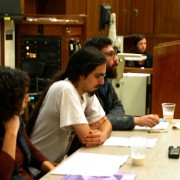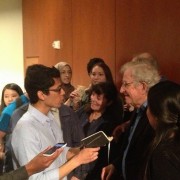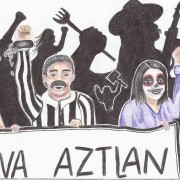DREAMers: Taking the Reins of their Cause
By Maribel Hastings – New America Media
WASHINGTON, D.C. – One group that has changed dramatically since past immigration battles – with help from the growing influence of social networking – are the so-called “DREAMers”: undocumented youth who would benefit from the proposed DREAM Act. The act would form part of a plan for comprehensive immigration reform, and has also been proposed as an independent bill.
The DREAMers didn’t come here by choice. They were brought to the United States as young children, or were victims of the broken immigration bureaucracy. The DREAM Act, which has bipartisan support, would grant them a path to legalization if they completed their studies or joined the military.
Each year, 65,000 undocumented students graduate from high schools across the country.
Over the past decade the DREAM Act has been proposed in Congress as its own bill and as part of other immigration bills, including the failed attempts at reform in 2006 and 2007.
After the failure of the 2007 reform bill, Senator Richard Durbin (D-IL) proposed it as a separate piece of legislation, but couldn’t secure the 60 votes required for debate.
Juan, a student and member of the DREAMActivist network–and one of the bill’s potential beneficiaries—believes that the 2007 setback sparked the creation of a more organized national movement.
“I think the main difference between now and 2007 was our decision to use the tools at our disposal and saturate every media channel possible to put a face on our cause, to humanize the issue,” Juan told America’s Voice.
It’s a movement that relies on volunteers — not an easy task, since the majority of the DREAMers, in addition to being undocumented, lack the resources to make frequent lobbying visits to Washington. But they have succeeded in halting deportations and they are present in every corner of the country. Their fight has been depicted in films such as Papers, which has been shown in various cities.
United We Dream is the coalition of local and national organizations advocating for the DREAM Act. Dream Activist is “United We Dream’s interactive page,” explained Marisol Ramos, co-founder and board member of the coalition and the New York State Youth Leadership Council.
The network aims to explain to the public and Congress that legalization doesn’t just make sense for humanitarian reasons, but also for economic competitiveness, as it would allow the US to tap an enormous quarry of talent.
Juan emphasized that the United States already allows undocumented students to attend elementary school, middle school and high school. “It’s like planting a fruit tree and then leaving the fruit to rot. They’re not benefiting from their own investment,” he pointed out.
Ironically, while the government promotes programs to encourage minority students — particularly Hispanics — not to drop out of school, it doesn’t legalize those who want to continue studying, or have completed their studies and want to work.
The DREAMers have established an organizational model that has enabled them to mobilize their cause without central offices or a budget of millions of dollars.
“Almost 100% of our work is voluntary,” declared Ramos, who, in addition to her regular workday, dedicates another seven hours of work to promote the DREAM Act on social-networking sites.
For Ramos, the setbacks of 2007 “confronted us with a cruel reality, but we’ve matured politically and we’ve made ourselves better activists.”
Walter Lara, whose deportation was suspended by the Department of Homeland Security (DHS), told America’s Voice, “my case is a good example of the DREAMers’ organizing capacity.” Compared to 2007, “there are definitely more organizations, they’re using the Web more than ever, they’re interacting effectively with other groups, and they’re taking advantage of every opportunity in social networks and traditional media to promote their cause,” he declared.
But the debate surrounding the DREAM Act has been complicated.
Part of the opposition comes from those who always complain about undocumented immigrants being “rewarded.” Others oppose certain provisions in the DREAM Act, such as the one offering legalization in exchange for military service.
And still others argue that passing the DREAM Act separately would hurt efforts to achieve comprehensive immigration reform. The same would be true of legalizing agricultural workers, they say. Without those two sectors, they worry that there won’t be the political will to consider the rest of the undocumented population.
But Ramos noted that many of the parents or relatives of the DREAMers are undocumented, and the wisdom they’ve gained in the process “has made them better activists and they’re ready not only to promote the DREAM Act, but other causes as well.”
“In the long term, this will help any cause,” Juan concluded.
The DREAM Act has been reintroduced in the current session of Congress.
In the Senate, it has been introduced as S. 729 by Senators Richard Durbin (D-IL) and Richard Lugar (R-IN). The bill has 32 cosponsors and has been sent to the Senate Judiciary Committee.
The corresponding House bill, which has 105 cosponsors and counting, is H.R. 1751.







Leave a Reply
Want to join the discussion?Feel free to contribute!